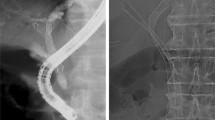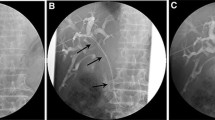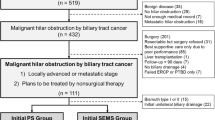Abstract
Background
Whether uni- or bilateral drainage should be performed for malignant hilar biliary obstruction remains a matter of debate. Moreover, endoscopic placement of bilateral metallic stents has been considered difficult and complicated. Although the Y-stent with a central wide-open mesh facilitates bilateral stent placement, it has limitations. This study evaluated the feasibility and efficacy of the Niti-S large cell D-type biliary stent (LCD) with a uniform large cell for both uni- and bilateral drainage of malignant hilar biliary obstruction.
Methods
From April 2008 to March 2009, a total of 12 consecutive patients with unresectable malignant hilar biliary obstruction of Bismuth type 2 or greater underwent placement of LCD. Before LCD placement, all the patients underwent endoscopic unilateral biliary drainage using a plastic stent or a nasobiliary drainage tube. If jaundice improved after the procedure, the plastic stent or nasobiliary drainage tube was replaced with the unilateral LCD. If jaundice did not resolve or contralateral cholangitis occurred, bilateral LCD placement was performed.
Results
Seven patients had unilateral and five patients had bilateral LCD placement. Technical success was achieved for all 12 patients. An early complication occurred for one patient (8%), and stent occlusion occurred for six patients (50%) because of tumor ingrowth (n = 4) or sludge (n = 2). These patients were managed by insertion of plastic stents (n = 4) or percutaneous transhepatic biliary drainage (n = 2). The median stent patency period was 202 days.
Conclusions
The newly designed endoscopic metallic stent may be feasible and effective for malignant hilar biliary obstruction, and endoscopic reintervention is relatively simple.



Similar content being viewed by others
References
Chang WH, Kortan P, Haber GB (1998) Outcome in patients with bifurcation tumors who undergo unilateral versus bilateral hepatic duct drainage. Gastrointest Endosc 47:354–362
De Palma GD, Galloro G, Siciliano S, Iovino P, Catanzano C (2001) Unilateral versus bilateral endoscopic hepatic duct drainage in patients with malignant hilar biliary obstruction: results of a prospective, randomized, and controlled study. Gastrointest Endosc 53:547–553
De Palma GD, Pezzullo A, Rega M, Persico M, Patrone F, Mastantuono L, Persico G (2003) Unilateral placement of metallic stents for malignant hilar obstruction: a prospective study. Gastrointest Endosc 58:50–53
Kim CW, Park AW, Won JW, Kim S, Lee JW, Lee SH (2004) T-configured dual stent placement in malignant biliary hilar duct obstructions with a newly designed stent. J Vasc Interv Radiol 15:713–717
Lee JH, Kang DH, Kim JY, Lee SM, Kim do H, Park CW, Cho HS, Kim GH, Kim TO, Heo J, Song GA, Cho M, Kim S, Kim CW, Lee JW (2007) Endoscopic bilateral metal stent placement for advanced hilar cholangiocarcinoma: a pilot study of a newly designed Y stent. Gastrointest Endosc 66:364–369
Yang KY, Ryu JK, Seo JK, Woo SM, Park JK, Kim YT, Yoon YB (2009) A comparison of the Niti-D biliary uncovered stent and the uncovered Wallstent in malignant biliary obstruction. Gastrointest Endosc 70:45–51
Isayama H, Nakai Y, Toyokawa Y, Togawa O, Gon C, Ito Y, Yashima Y, Yagioka H, Kogure H, Sasaki T, Arizumi T, Matsubara S, Yamamoto N, Sasahira N, Hirano K, Tsujino T, Toda N, Tada M, Kawabe T, Omata M (2009) Measurement of radial and axial forces of biliary self-expandable metallic stents. Gastrointest Endosc 70:37–44
Nakai Y, Isayama H, Tsujino T, Kawabe T, Yashima Y, Yagioka H, Kogure H, Sasaki T, Togawa O, Arizumi T, Ito Y, Matsubara S, Hirano K, Sasahira N, Tada M, Omata M (2008) Intraductal US in the assessment of tumor involvement to the orifice of the cystic duct by malignant biliary obstruction. Gastrointest Endosc 68:78–83
Isayama H, Kawabe T, Nakai Y, Tsujino T, Sasahira N, Yamamoto N, Arizumi T, Togawa O, Matsubara S, Ito Y, Sasaki T, Hirano K, Toda N, Komatsu Y, Tada M, Yoshida H, Omata M (2006) Cholecystitis after metallic stent placement in patients with malignant distal biliary obstruction. Clin Gastroenterol Hepatol 4:1148–1153
Peters RA, Williams SG, Lombard M, Karani J, Westaby D (1997) The management of high-grade hilar strictures by endoscopic insertion of self-expanding metal endoprostheses. Endoscopy 29:10–16
Freeman ML, Overby C (2003) Selective MRCP- and CT-targeted drainage of malignant hilar biliary obstruction with self-expanding metallic stents. Gastrointest Endosc 58:41–49
Deviere J, Baize M, de Toeuf J, Cremer M (1988) Long-term follow-up of patients with hilar malignant stricture treated by endoscopic internal biliary drainage. Gastrointest Endosc 34:95–101
Hookey LC, Le Moine O, Deviere J (2005) Use of a temporary plastic stent to facilitate the placement of multiple self-expanding metal stents in malignant biliary hilar strictures. Gastrointest Endosc 62:605–609
Polydorou AA, Chisholm EM, Romanos AA, Dowsett JF, Cotton PB, Hatfield AR, Russell RC (1989) A comparison of right versus left hepatic duct endoprosthesis insertion in malignant hilar biliary obstruction. Endoscopy 21:266–271
Sherman S (2001) Endoscopic drainage of malignant hilar obstruction: is one biliary stent enough or should we work to place two? Gastrointest Endosc 53:681–684
Park do H, Lee SS, Moon JH, Choi HJ, Cha SW, Kim JH, Seo DW, Lee SK, Park SH, Lee MS, Kim SJ, Kim MH (2009) Newly designed stent for endoscopic bilateral stent-in-stent placement of metallic stents in patients with malignant hilar biliary strictures: multicenter prospective feasibility study (with videos). Gastrointest Endosc 69:1357–1360
Kim JY, Kang DH, Kim HW, Choi CW, Du Kim I, Hwang JH, Kim DU, Eum JS, Bae YM (2009) Usefulness of slimmer and open-cell-design stents for endoscopic bilateral stenting and endoscopic revision in patients with hilar cholangiocarcinoma (with video). Gastrointest Endosc 70:1109–1115
Disclosures
Hirofumi Kogure, Hiroyuki Isayama, Yousuke Nakai, Takeshi Tsujino, Yukiko Ito, Keisuke Yamamoto, Suguru Mizuno, Hiroshi Yagioka, Kazumichi Kawakubo, Takashi Sasaki, Kenji Hirano, Naoki Sasahira, Minoru Tada, Masao Omata, and Kazuhiko Koike have no conflicts of interest or financial ties to disclose.
Author information
Authors and Affiliations
Corresponding author
Rights and permissions
About this article
Cite this article
Kogure, H., Isayama, H., Nakai, Y. et al. Newly designed large cell Niti-S stent for malignant hilar biliary obstruction: a pilot study. Surg Endosc 25, 463–467 (2011). https://doi.org/10.1007/s00464-010-1194-8
Received:
Accepted:
Published:
Issue Date:
DOI: https://doi.org/10.1007/s00464-010-1194-8




